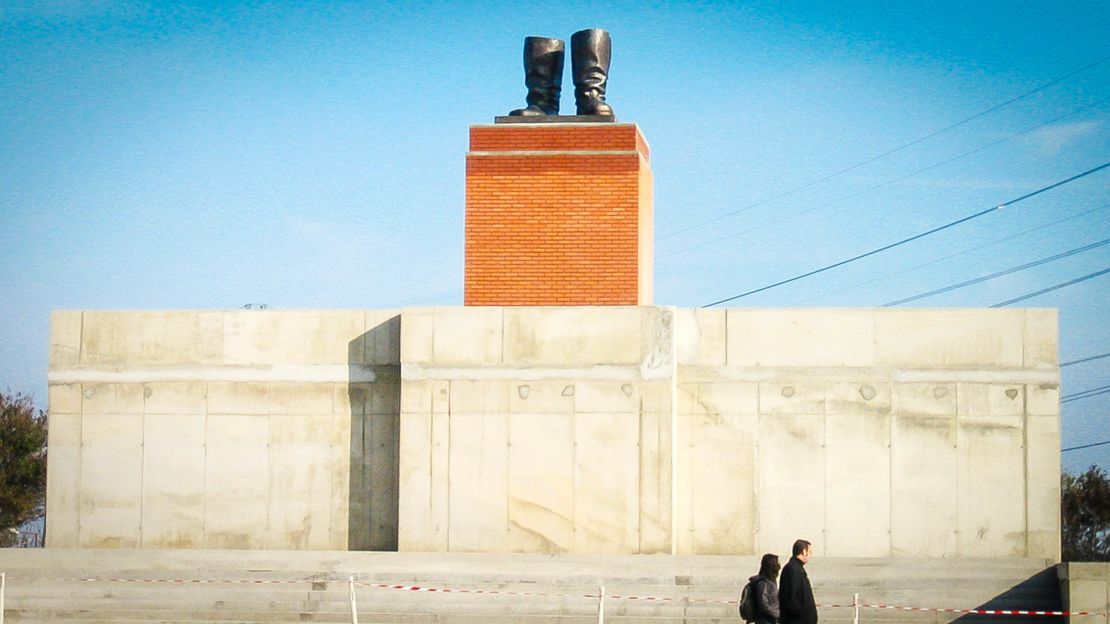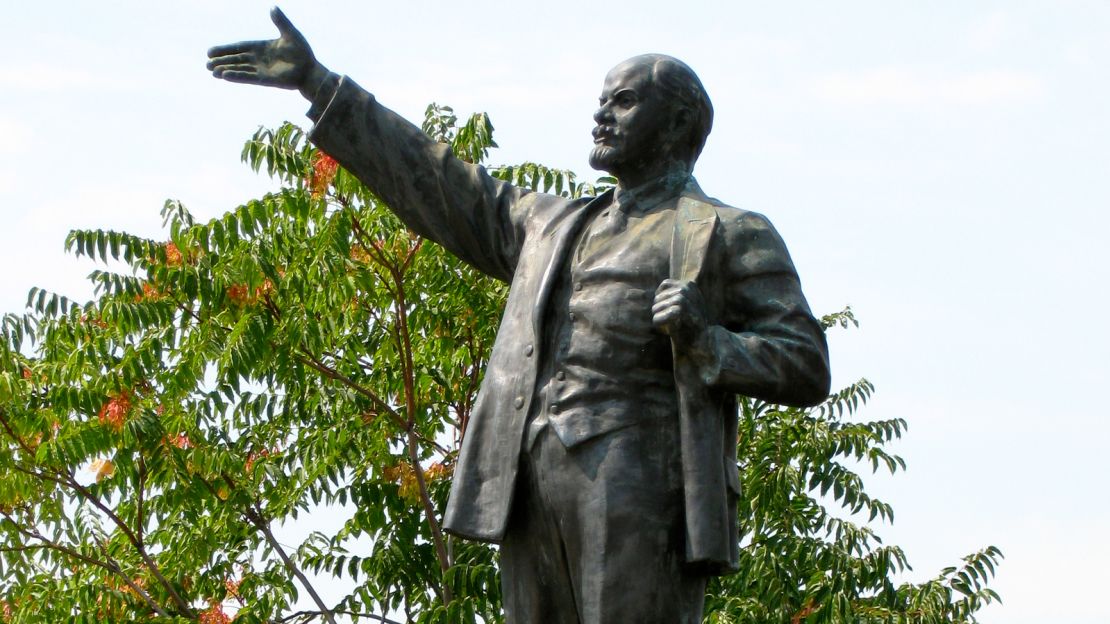Vladimir Lenin stands with Karl Marx and notable Hungarian communist leaders behind the austere brick walls of a unique, if not surreal, statue park museum up in the hilly southern suburbs of Budapest.
Reminders of the dictatorship were ripped out from the city center and hidden out of sight when the Iron Curtain came tumbling down in 1989.
Shortly after the fall of communism in 1991, Memento Park became the place where these communist statues went to die. (Memento Park, Budapest, Balatoni út - Szabadkai utca sarok, 1223 Hungary; +36 1 424 7500)
Although it’s far from the buzz of downtown Budapest, the park still draws in thousands, with most guidebooks listing it as a must-see.
Monumental cemetery
Communist statues find a home in Budapest park
It’s hard to miss the entrance of Memento, a calamity of red bricks that look like a social realist homage to a Greek temple.
Proletariat anthems blast out from a small kiosk where visitors can purchase tickets to the park along with communist memorabilia (and CDs of the above mentioned proletariat anthems).
The sight of the monuments standing deep in snow gives the park that extra “Soviet” feel – until tourists come to throw snowballs at Lenin and sculpt socialist snowmen.
Parked just inside the gate, an old Trabant – a classic car manufactured in East Germany that was popular in pre-1990s Hungary – presents an interactive art installation.
Beside it is a phone box where you can listen to the voices of Joseph Stalin, Mao Zedong, Che Guevara and Hungarian figures from the Communist Party.
“This phone can not be used to make national or international calls, it only allows you to travel back in time,” says the sign taped up inside.
Beyond is a bronze cast of socialist figures once prominent residents in city center.
Memento was devised by Hungarian architect Ákos Eleőd, who won a competition to design it back in 1991, and describes it as a park “about dictatorship.”
There are around 42 statues scattered around the park and each tells its own story.
Some are obvious, like Lenin poised on a plinth, captured in the middle of a speech.
Others are busts of Hungarian communist leaders who are less known internationally than their Russian overlords. Some are allegorical, like a gigantic pair of hands holding a globe-like object.
Communist-era relics

Opposite the entrance, a pair of gigantic boots sits on top of a huge grandstand.
This is a tribute to the original eight-meter-high bronze statue of Stalin which was torn down during the Hungarian Revolution on October 23, 1956.
That statue was pulled down and sawed until only the boots were left.
Today, the replica is a keepsake of the revolution, and in its odd way, of Stalin.
Visitors can hike up the stairs that run behind the monument to the balcony, where they’ll be treated to a great view of the park entrance.
The bunker-like interior inside the grandstand is worth checking out. Here, statues and busts of Lenin collect dust in the dark, including strange relics of the communist revolutionary as a child.
The barracks next to the grandstand has an exhibition on the fall of the communist regime.
Footage of Hungary’s Secret Police in training is shown here in a small screening room. Several hundred short films were shot between 1958 and 1988, to train and instruct secret agents and spies to defend the “law and order.”
The short excerpts last around 10 to 15 minutes, providing a fascinating window into this once covert operation. Among practical tips offered is a guide to installing a secret camera in your handbag to spy on your neighbor.
Memento can be reached via local bus 150 in the direction of Campona, which can be boarded from the Kelenföld train station (Metro Line 4) or Újbuda-központ.
There’s also a direct bus service from Deák Ferenc Square that leaves at 11 a.m. every day and shuttles passengers to the gates of the park.
Memento Park is open from 10 a.m to dusk all year round.
Signs of the past

For those craving further insight into social realism and Hungarian life behind the Iron Curtain, traces of its history can be found scattered around Budapest in more subtle ways.
The city’s street names are one source. Some signs will have names crossed out in red and replaced with new ones, which usually references a name given under communism or communist connotations.
Also, while several of the statues originally placed in citadel on Gellért Hill now stand in Memento Park, several imposing Social realism statues remain here their original location.
For a more lighthearted trip back in time, there’s the Children’s Railway in the Buda Hills, which is staffed almost entirely by schoolkids. Once part of the Pioneer Group, an organization for children run by Hungary’s Communist party, this retro railway has all the charm of its original incarnation but none of the socialist ideology.
For a hands-on experience of retro Hungary, it’s possible to climb behind the wheel of a Trabant (Rent a Trabant; +36 30 946 3484) to explore the city.
Since the collapse of communist rule, Trabbies have attained cult status. Some have been maintained for posterity and are now hired out to visitors brave enough to pilot an underpowered two-stroke engine through the streets.
At Bambi Eszpresszó, customers can find a caffeine fueled institution that’s been going strong since the 1960s where very little has changed, from the black coffee to the red plastic seats (Frankel Leó út 2/4, Budapest; +36 1 212 3171).
Another Budapest institution is the Tisza Shoes store (Károly krt. 1, Budapest; +36 1 266 3055). The Tisza sporting footwear brand dates back to 1971, when it was the only choice for locals. While the arrival of capitalism initially killed it off, Tisza’s popularity proved so enduring it was revived as a retro-cool, if somewhat more exclusive, label.
Original communist memorabilia can still be found for sale in Budapest at Ecseri Piac.
This huge flea market is a permanent fixture in the city, open Monday to Saturday from 8 a.m. to 4 p.m. (3 p.m. on Saturday) selling pretty much everything.
Portraits of Lenin and communist memorabilia can be found among the porcelain figurines, antique gramophones and used cameras.
To get here, head to to Boráros tér in Pest, and catch the 54 or 55 bus to Használtcikk Piac.
Jennifer Walker is an Anglo-Hungarian writer and former physicist living in Budapest. She tweets at @JDWalkerWriter.
CNN Travel series often carries sponsorship originating from the countries and regions we profile. However CNN retains full editorial control over all of its reports. Read the policy.






























